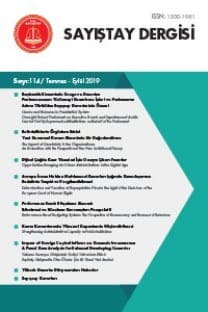CONSTRUCTION OF A FINANCIAL INCLUSION INDEX FOR THE MEMBER AND CANDIDATE COUNTRIES OF THE EUROPEAN UNION
AVRUPA BİRLİĞİ ÜYE VE ADAY ÜLKELERİ İÇİN BİR FİNANSAL KAPSAYICILIK İNDEKSİ
___
- Arora, R. (2010), "Measuring Financial Access", http://equella.rcs.griffith.edu. au/research /file/fd0408e2-75c5-c430-ea2d-2fe7274a467f/1/2010- 07-measuring-financial-access (Erişim Tarihi: 07.15.2010).
- Barr, M. (2004), "Banking the Poor", Yale Journal on Regulation 21.
- Beck, T., Demirguc-Kunt, A., Soledad,M., Peria, M. (2007), "Reaching out: Access to and use of Banking Services across Countries", Journal of Financial Economics, 85, pp. 234-266.
- Buckland, J., B. Guenther, G. Boichev, H. Geddie, M. Mutch, (2005), "There are No Banks Here: Financial and Insurance Exclusion Services in Winnipeg's North End", Winnipeg Inter-City Research Alliance.
- CGCGCCCGAP ve World Bank (2010), Financial Access 2010: The State of Financial Inclusion through the Crisis, Washington, DC, Consultative Group to Assist the Poor/The World Bank Group, http://www.cgap.org/ publications/financial-access-2010.
- Chakravarty, S. R., ve Pal, R. (2010), Measuring Financial Inclusion : An Axiomatic Approach Measuring Financial Inclusion : An Axiomatic Approach, (March).
- Collard, S., E. Kempson ve Whyley, C. (2001), Tackling Financial Exclusion - An Area-Based Approach, The Policy Press, UK.
- Connolly, C., Hajaj, K. (2001), "Financial Services and Social Exclusion", Financial Services Consumer Policy Centre, University of New South Wales.
- Corr, C., (2006), "Financial Exclusion in Ireland: An Exploratory Study and Policy Review", Combat Poverty Agency Research Series 39.
- Djankov, S., P. Miranda, E. Seira, S. Sharma, (2008), "Who are the Unbanked ?", World Bank Policy Research Working Paper 4647.
- European Commission, (2008), "Financial services Provision and Prevention of Financial Exclusion" Report by the Director General for Employment, Social Affairs and Equal Opportunities, European Commission.
- Gupte, R., Venkataramani, B., & Gupta, D. (2012), Computation of Financial Inclusion Index for India, Procedia - Social and Behavioral Sciences, 37, 133-149.
- Hannig, A. ve Jansen, S. (2010), "Financial Inclusion and Financial Stability: Current Policy Issues", ADBI Working Paper No. 259.
- Kempson, E., Whyley, C. (1998), "Access to Current Accounts", British Bankers' Association, London.
- Kempson, E., C. Whyley (2001), "Payment of Pension and Benefits", Department for Work and Pension, London.
- Leyshon, A. ve Thrift, N. (1995), "Geographies of Financial Exclusion: Financial Abandonment in Britain and the United States", Transactions of the Institute of British Geographers New Series, 20, pp. 312-41.
- Porteous, David (2009), "Key Issues in Design and Implementation of Surveys on Financial Inclusion", Presented at the Alliance for Financial Inclusion Global Policy Forum, www.afi-global.net/downloads/GPF_David_Porteous.pdf (Nairobi, September 15).
- Sarma, M. ve Pais, J. (2008), "Financial Inclusion and Development: A Cross Country Analysis", Annual Conference of the Human Development and Capability Association, New Delhi, http://www.innosocial.in/services/ financial-inclusion/Kofi Annan (Accessed on 25.10.2011).
- Sarma, M. (2008), Index of Financial Inclusion, Working Paper 215, Indian Council for Research on International Economic Relations.
- Seidman, E. ve Tescher, J. (2004), "From Unbanked to Homeowner: Improving the Supply of Financial Services for Low-Income, Low-Asset Customers", The Centre for Financial Services Initiative.
- Solo, T. M ve Manroth, A. (2006), "Access to Financial Services in Colombia - The Unbanked in Bogota", World Bank Policy Research Paper 3834.
- Yorulmaz, R. (2013), "Construction of a Regional Financial Inclusion Index in Turkey", BDDK Bankacılık ve Finansal Piyasalar Dergisi, Cilt: 7, Sayı: 1.
- ISSN: 1300-1981
- Yayın Aralığı: 4
- Başlangıç: 1990
- Yayıncı: T.C. Sayıştay Başkanlığı
KARAR VERME YAKLAŞIMLARI ÜZERİNDE HERBERT SIMON HEGEMONYASI
TÜRKİYE'DE SAĞLIK HARCAMALARI İLE EKONOMİK BÜYÜME ARASINDAKİ İLİŞKİ
İL ÖZEL İDARELERİNDE GERÇEKLEŞTİRİLEN DÜZENLİLİK VE PERFORMANS DENETİMLERİNE AİT BULGULARIN ANALİZİ
KALKINMA AJANSLARINDAN AYRILAN PERSONELİN HAREKETLİLİĞİ HAKKINDA BİR İNCELEME
Tuğba DENİZ, Deniz CİNOĞLU ŞAHİN, Ahmet ŞİMŞEK
SOSYAL BELEDİYECİLİK ANLAYIŞININ E-BELEDİYECİLİK UYGULAMALARINA ENTEGRE EDİLMESİ
